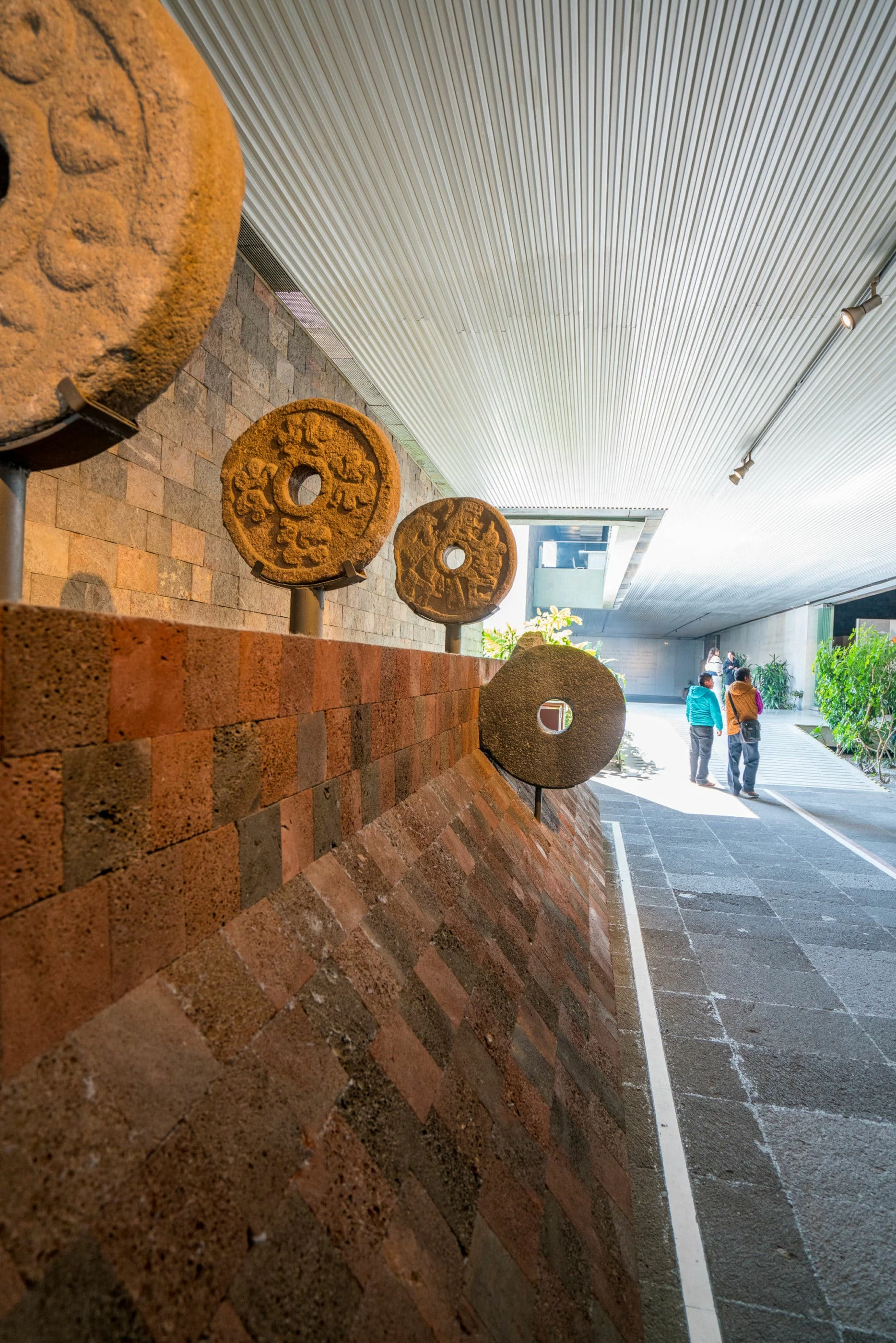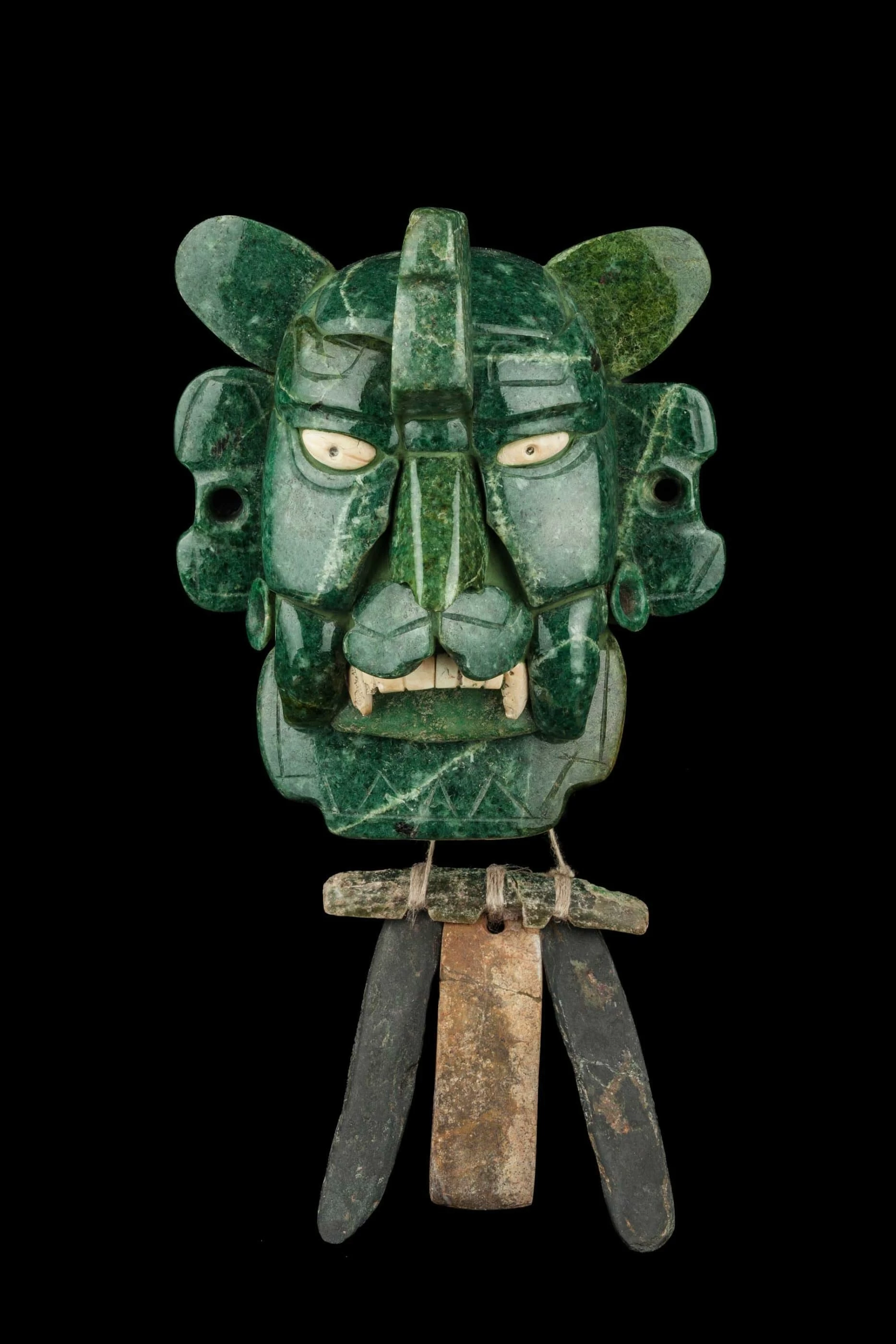Museo National de Antropologia, or the National Museum of Anthropology in English, is famous and the most visited Mexico City museum. We look forward to going when traveling to Mexico City and will share what to see that draws so many visitors every year from around the world.
This enormous museum opened to the public in 1964 and traces the history of human habitation going back millennia throughout the now the nation of Mexico (and beyond). Separate exhibition spaces, mostly indoor gallery halls but also some spectacular outdoor exhibits, explore this broad topic by time period and region.
Of course, some of the civilizations that came and went were more spectacular and more historically notable than others. Some left more monumental or artistically captivating relics of their presence. The Aztecs are first among equals here. And perhaps that’s fitting because Mexico City sits on the site of their wonderous capital, Tenochtitlan, originally built on an island in the middle of a vast lake, which the Spanish first saw with their own eyes in 1519, over 500 years ago now.
Like any great museum of the world, such as the Louvre in Paris or the Metropolitan Museum of Art in New York, this museum has its own handful of absolutely must-see things in its collection of over 600,000 artifacts.
Tips for Visiting With Kids
Kids seem to find the gory aspects of Aztec and Mayan history intriguing and resonate with a lot of the animal carvings and religious symbolism around the sun and the moon that can be seen here.
One day — and my daughter can now attest to this — they’ll open the pages of a school textbook someday and see these artifacts if they haven’t already. This is largely why the museum is on our list of best things to do in Mexico City with kids. With a young child in tow, an hour or two is all you need.
You may want to consider taking a virtual tour of the museum with the kids in advance to familiarize them with what’s inside.
Aztec Sunstone

Piedra del Sol is the Mona Lisa of the National Museum of Anthropology’s collection — an absolute must-see. This enormous stone circle (reportedly weighing 23 tons) was crafted by the Aztecs and was originally sited in their capital Tenochtitlan.
Discovered during the construction of Mexico City’s Metropolitan Cathedral (which still stands today in the Zocalo, just a few miles away from this museum), its originally intended use and meaning is still a matter of some scientific discussion but the carvings showcase the Aztec cosmic cycles, importance of warfare, and the relationship between humans and gods The face at the center, with its tongue sticking out as part of an Aztec bloodletting ritual, is striking and iconic.
Moctezuma II Ceremonial Headdress

Moctezuma II was the Aztec leader at the time of the Spanish Conquest 500 years ago. A slightly different version of his name is familiar to many Americans from the old phrase, “Montezuma’s Revenge.” In any event, this enormous, brightly colored, spectacular headdress, made of the feather of peacocks and other birds, hangs on a wall not far from the Aztec Sunstone. While this is a famous part of the museum’s collection, and it is visually stunning, it is ‘merely’ a replica. (The alleged ‘original’ is in a museum in Vienna, Austria.)
Model of Tenochtitlan

A fantastic scale model of the original Aztec capital of Tenochtitlan is displayed at the National Museum of Anthropology. As mentioned above, the Aztecs originally built their capital on a small island in the middle of a vast lake. By the time the Spanish arrived in 1519, the Aztecs had vastly expanded this island to make a much bigger capital city. They also built four causeways to the mainland, where more people lived.
The lake is long gone, and modern Mexico City is located on this once wonderous site of a gleaming island capital. This large model really helps the modern visitor understand what the very unusual, dream-like city really looked like. A large mural depicting the Aztec capital hangs on the wall above the model, further helping visitors grasp its long-gone magnificence.
Chacmool and Other Heart Receptacles
In the same room as the Aztec Sunstone, you’ll see several pre-Columbian Mesoamerican sculptures called chacmool that have been taken from various temples. The most famous are the human-like chacmool with their heads turned 90 degrees.
During rituals to spill blood in order to create good harvests. The hearts of warriors we carved out and put in the bowls at the center of the chacmool, before their bodies were pushed down the temple stairs.
Olmec Colossal Head

If you’re considering visiting this museum, you’re almost certainly familiar with the giant stone heads carved from basalt boulders nearly three thousand years ago by the Olmecs, even if you didn’t know they were of Olmec origin specifically or 3,000 years old. These giant, round stone heads are icons of Mesoamerican archaeology.
Ball Game Goal, Chichen Itza

Chichen Itza, one of the biggest Mayan city-states, is located in the Yucatan jungle and is visited by hordes of tourists each year, despite being somewhat remotely located. Famously (or infamously) some Mayans played a high stakes, ritual ball game in which opposing teams tried to get a rubber ball about the size of a basketball through a stone ring suspended high in the air in a stone ball court.
The penalty for losing this ritual game could apparently be death. Chichen Itza has a very well preserved ball court. At this kid-friendly Mexico City museum, you can see an example (albeit a smaller one) of what one of these giant ball court rings at Chichen Itza actually looked like.
Jade Mask of Zapotec Bat God

This stunning jade relic was found at Monte Alban, a key city of the Zapotecs in what is today Oaxaca, and is believed to have been made sometime between 100 BC and 200 AD. Bats were important symbolically to several Mesoamerican civilizations, including the Zapotecs. In part, this was because they lived in caves, which the people believed connected them to the sacred underworld, and in part because their vampiric nature impliedly referenced their own blood-letting rituals that they believed secured good crop harvests.
Recreation of Pakal’s Tomb

Palenque was one of the largest and most important Mayan cities. The tomb of one of the city state’s longest and most important rulers Pakal (or Pacal) I was discovered in the 1950s and is a famously eye-catching and intact collection of Mayan jewels, artworks, and carvings.
Unfortunately, the Mexican state of Chiapas has developed a reputation for being unsafe for many years so the opportunity for tourists and casual visitors to see the original is limited. But this museum houses a spectacular recreation, including Pakal’s jade funerary mask.
El Paraguas (The Umbrella)

As noted above, this large, modern museum has indoor and outdoor exhibit areas. The Mexico City museum is built around a central courtyard. In the center is a multi-story concrete column that is a stunning water feature, instantly recognizable by anyone who has ever seen it in person.
Note that this column is not an archaeological relic. It is an architectural feature built when the museum was constructed and opened to the public in 1964. It’s designed to represent the human connection to nature.
Fabulous Location and Other Details
The National Museum of Anthropology is located in gorgeous Chapultepec Forest, just a few minutes’ walk from the lake and about a 20-minute walk from Four Seasons Hotel Mexico, D.F. where we stay.
On Sundays, Mexico City museums are free to residents so avoid any museum (if possible) on this day because they are crowded. On Mondays, the museum is closed, as are most of the museums in town. Plan your visit to Mexico City around these days, however, on Mondays, Teotihuacan is still open so you can take a half-day or day trip out there.
Not a history buff? You can tour with an audio guide. A self-tour is actually easy because the museum is laid out in a circular format divided up into salons. Each salon showcases a different region or culture including Teotihuacan, Toltec, Aztec, Mixtec, Zapotec, Olmec, and Maya.
National Museum of Anthropology
(Museo Nacional de Antropologia)
Avenida Paseo de la Reforma
Chapultepec Polanco
Mexico City 11560
Mexico

















Leave a Reply